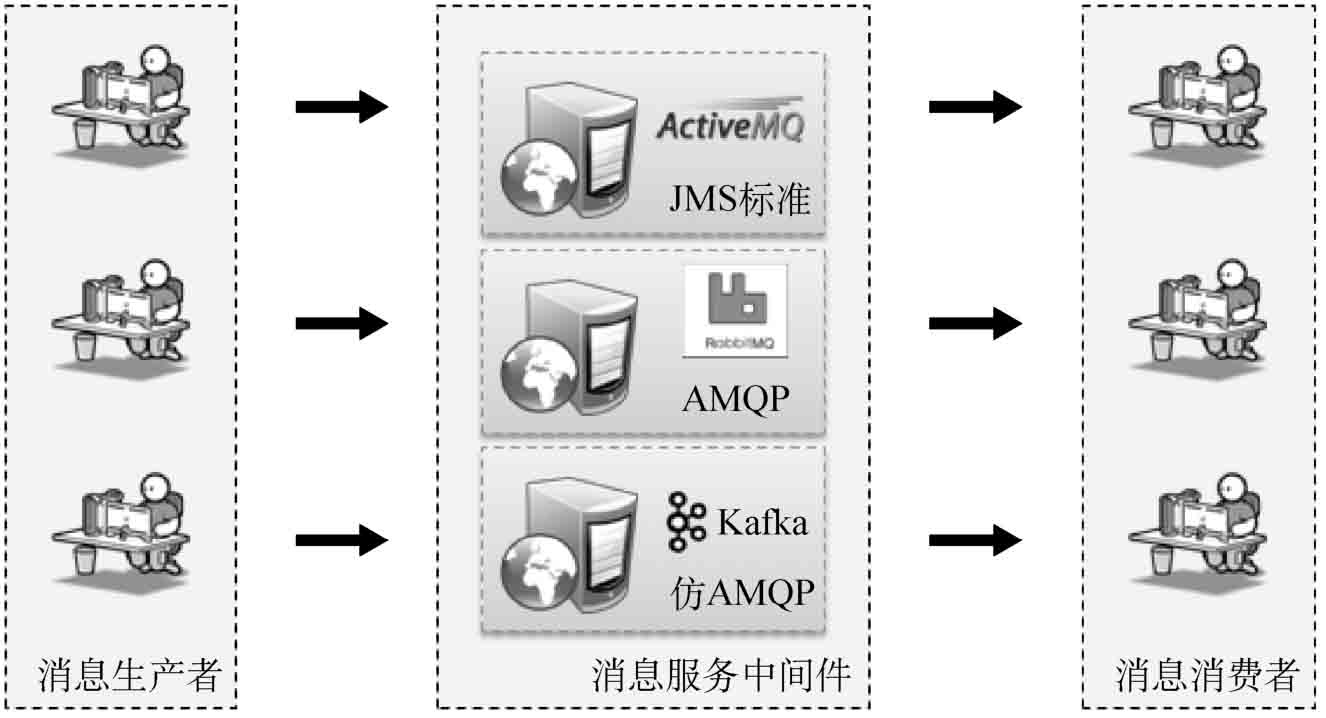在进行分布式系统设计时,经常会使用消息服务组件进行系统整合与异步服务通信,其基本结构为生产者与消费者处理。常用的消息组件主要包括两类:JMS标准(ActiveMQ)和AMQP标准(RabbitMQ、Kafka)。

SpringBoot整合ActiveMQ消息组件
ActiveMQ是Apache提供的开源组件,是基于JMS标准的实现组件。下面将利用SpringBoot整合ActiveMQ组件,实现队列消息的发送与接收。
1、引入依赖
修改pom.xml配置文件,追加spring-boot-starter-activemq依赖库。
<dependency>
<groupId>org.springframework.boot</groupId>
<artifactId>spring-boot-starter-activemq</artifactId>
</dependency>2、修改配置文件
修改application.yml配置文件,进行ActiveMQ的配置。
spring:
jms:
pub-sub-domain: false # 配置消息类型,如果是true则表示为topic消息,如果为false表示Queue消息
activemq:
user: admin # 连接用户名
password: admin # 连接密码
broker-url: tcp://activemq-server:61616 # 消息组件的连接主机信息3、编写消息者代码
定义消息消费监听类。
@Service
public class MessageConsumer {
@JmsListener(destination="mldn.msg.queue") // 定义消息监听队列
public void receiveMessage(String text) { // 进行消息接收处理
System.err.println("【*** 接收消息 ***】" + text);
}
}4、编写生产者代码
定义消息生产者业务接口。
public interface IMessageProducer {
public void send(String msg) ; // 消息发送
}定义消息业务实现类。
@Service
public class MessageProducerImpl implements IMessageProducer {
@Autowired
private JmsMessagingTemplate jmsMessagingTemplate; // 消息发送模版
@Autowired
private Queue queue; // 注入队列
@Override
public void send(String msg) {
this.jmsMessagingTemplate.convertAndSend(this.queue, msg); // 消息发送
}
}5、创建队列配置类
定义JMS消息发送配置类,该类主要用于配置队列信息。
@Configuration
@EnableJms
public class ActiveMQConfig {
@Bean
public Queue queue() {
return new ActiveMQQueue("mldn.msg.queue") ; // 定义队列名称
}
}每当有消息接收到时,都会自动执行MessageConsumer类,进行消息消费。
SpringBoot整合RabbitMQ消息组件
RabbitMQ是一个在AMQP基础上构建的新一代企业级消息系统,该组件由Pivotal公司提供,使用ErLang语言开发。
提示:RabbitMQ与SpringCloud整合之中意义重大。
SpringCloud是在SpringBoot基础上构建的微架构技术开发框架,其中的SpringCloudConfig自动刷新机制就基于消息组件完成,并且推荐使用RabbitMQ消息组件(同属于Pivotal公司产品)。在SpringCloudStream中也使用RabbitMQ作为服务组件。
1、引入依赖
修改pom.xml配置文件,追加spring-boot-starter-amqp依赖包。
<dependency>
<groupId>org.springframework.boot</groupId>
<artifactId>spring-boot-starter-amqp</artifactId>
</dependency>2、修改配置文件
修改application.yml配置文件,进行RabbitMQ的相关配置。
spring:
rabbitmq:
addresses: rabbitmq-server # rabbitmq服务主机名称
username: admin # 用户名
password: admin # 密码
virtual-host: / # 虚拟主机3、消息生产配置类
为了可以正常使用RabbitMQ进行消息处理,还需要做一个消息生产配置类。
@Configuration
public class ProducerConfig {
public static final String EXCHANGE = "xxl.microboot.exchange"; // 交换空间名称
public static final String ROUTINGKEY = "xxl.microboot.routingkey"; // 设置路由key
public static final String QUEUE_NAME = "xxl.microboot.queue"; // 队列名称
@Bean
public Binding bindingExchangeQueue(DirectExchange exchange,Queue queue) {
return BindingBuilder.bind(queue).to(exchange).with(ROUTINGKEY) ;
}
@Bean
public DirectExchange getDirectExchange() { // 使用直连的模式
return new DirectExchange(EXCHANGE, true, true);
}
@Bean
public Queue queue() { // 队列信息
return new Queue(QUEUE_NAME);
}
}4、编写生产者代码
建立消息发送接口。
public interface IMessageProducer {
public void send(String msg) ; // 消息发送
}建立消息业务实现子类。
@Service
public class MessageProducerImpl implements IMessageProducer {
@Resource
private RabbitTemplate rabbitTemplate;
@Override
public void send(String msg) {
this.rabbitTemplate.convertAndSend(ProducerConfig.EXCHANGE,
ProducerConfig.ROUTINGKEY, msg);
}
}5、消息消费配置类
建立一个消息消费端的配置程序类。
@Configuration
public class ConsumerConfig {
public static final String EXCHANGE = "xxl.microboot.exchange"; // 交换空间名称
public static final String ROUTINGKEY = "xxl.microboot.routingkey"; // 设置路由key
public static final String QUEUE_NAME = "xxl.microboot.queue"; // 队列名称
@Bean
public Queue queue() { // 队列信息
return new Queue(QUEUE_NAME);
}
@Bean
public DirectExchange getDirectExchange() { // 使用直连的模式
return new DirectExchange(EXCHANGE, true, true);
}
@Bean
public Binding bindingExchangeQueue(DirectExchange exchange,Queue queue) {
return BindingBuilder.bind(queue).to(exchange).with(ROUTINGKEY) ;
}
}6、编写消费者代码
定义监听处理类。
@Service
public class MessageConsumer {
@RabbitListener(queues="xxl.microboot.queue")
public void receiveMessage(String text) { // 进行消息接收处理
System.err.println("【*** 接收消息 ***】" + text);
}
}此时程序实现了与RabbitMQ消息组件的整合,同时在整个程序中只需要调用IMessageProducer接口中的send()方法就可以正常发送,而后会找到设置同样ROUTINGKEY的消费者进行消息消费。
SpringBoot整合Kafka消息组件
Kafka是新一代的消息系统,也是目前性能最好的消息组件,在数据采集业务中被广泛应用。本程序中配置的Kafka将基于Kerberos认证实现消息组件处理。
1、定义客户端文件
【操作系统-Windows】定义一个Kerberos客户端文件,路径为d:\kafka_client_jaas.conf。
KafkaClient {
org.apache.kafka.common.security.plain.PlainLoginModule required
username="bob"
password="bob-pwd";
};2、引入kafka依赖
修改pom.xml配置文件,追加依赖库配置。
<dependency>
<groupId>org.springframework.kafka</groupId>
<artifactId>spring-kafka</artifactId>
</dependency>3、修改配置文件
修改application.yml配置文件,进行Kafka配置项编写。
spring:
kafka:
bootstrap-servers: # 定义主机列表
- kafka-single:9095
template:
default-topic: xxl-microboot # 定义主题名称
producer: # 定义生产者配置
key-serializer: org.apache.kafka.common.serialization.StringSerializer
value-serializer: org.apache.kafka.common.serialization.StringSerializer
consumer: # 定义消费者配置
key-deserializer: org.apache.kafka.common.serialization.StringDeserializer
value-deserializer: org.apache.kafka.common.serialization.StringDeserializer
group-id: group-1 # 数据分组
properties:
sasl.mechanism: PLAIN # 安全机制
security.protocol: SASL_PLAINTEXT # 安全协议4、编写消息发送代码
定义消息业务发送接口。
public interface IMessageProducer {
public void send(String msg) ; // 消息发送
}使用Kafka消息机制实现消息发送接口。
@Service
public class MessageProducerImpl implements IMessageProducer {
@Resource
private KafkaTemplate<String, String> kafkaTemplate; // Kafka消息模版
@Override
public void send(String msg) {
this.kafkaTemplate.sendDefault("mldn-key", msg); // 发送消息
}
}5、编写消息消费代码
建立一个Kafka消息的消费程序类。
@Service
public class MessageConsumer {
@KafkaListener(topics = {"mldn-microboot"})
public void receiveMessage(ConsumerRecord<String, String> record) { // 进行消息接收处理
System.err.println("【*** 接收消息 ***】key = " + record.key() + "、value = "
+ record.value());
}
}6、修改启动类
由于此时Kafka采用Kerberos认证,因此需要修改程序启动主类。
@SpringBootApplication // 启动SpringBoot程序,而后自带子包扫描
public class SpringBootStartApplication { // 必须继承指定的父类
static {
System.setProperty("java.security.auth.login.config",
"d:/kafka_client_jaas.conf"); // 表示系统环境属性
}
public static void main(String[] args) throws Exception {
SpringApplication.run(SpringBootStartApplication.class, args); // 启动SpringBoot程序
}
}此时,可以通过测试程序调用IMessageProducer接口进行消息发送,由于Kafka已经配置了自动创建主题,所以即使现在主题不存在,也不影响程序执行。
